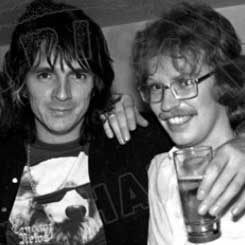The Real Rock & Roll Hall Of Fame: Steve Morse
Purple’s longest-serving guitarist speaks.

On April 18, Lou Reed, Green Day, Ringo Starr, Joan Jett and others will be inducted into the Rock And Roll Hall Of Fame, joining everyone from The Beatles, the Stones, Led Zeppelin, Pink Floyd and The Who to Kiss, Metallica, ZZ Top and, er, ABBA. But what about all the bands this US institution has overlooked, ignored or wilfully snubbed over the years? The giants and innovators of rock, prog, punk, blues and more who weren’t deemed important enough, cool enough or American enough to warrant entry through those hallowed portals. Nearly 50 years after forming, Deep Purple are the greatest band not to be in the official Hall Of Fame. They are one of a diminishing handful of bands who formed in the late 60s who are still active today, who are not content to rest on their laurels and who still exist in a meaningful and creative way. While many of their peers are content to play the chicken-in-a-basket circuit – their tour posters emblazoned with monochrome mug shots of how they looked back in their bushy-tailed heyday – Purple have matured like a fine, expensive wine (a Sweet Burgundy, as their former guitarist, the late, great Tommy Bolin, might have it). From 1968’s Shades Of Deep Purple to 2013’s NOW What?!, Purple’s passage through time resembles a mountain range of breathtaking highs and turbid lows. Via a series of interviews with every key member past and present, we celebrate Purple’s extraordinary, multi-decade career. We highlight the radically different personalities of the musicians who have impacted on the band, and marvel at how these contradicting characters were able to gel musically. We examine the mysterious – and occasionally devious – workings of this at times most volatile of bands. We analyse the contributions of alleged bit-part players including Nick Simper, Joe Lynn Turner and the aforementioned Bolin. Plus much more besides. This is Deep Purple dissected, deconstructed and laid bare. (Oh, and we only mention Smoke On The Water once.)
Have you ever met Ritchie Blackmore?
No. But I’ve met his son, Jürgen, several times.
Would you have much in common with Ritchie?
Sure. Ritchie must know that I’m in the band.
You’d think so by now.
Ha! Yeah. But you know what? I think Ritchie has given me a pass. If he wanted to destroy me with words then I would be an easy target for him in his interviews. And he hasn’t done that at all. I do play his material with a great deal of respect, but I put in enough of my own personality to make it genuine.
Sign up below to get the latest from Classic Rock, plus exclusive special offers, direct to your inbox!
What’s the most rock’n’roll thing you’ve ever done?
Purple played a gig in Chile, and there was this guy at the front that could spit like a llama. He hit me several times. The last time he did it, it went into my mouth. At the end of the show he was gloating, pointing at his chest: “That was me.” I just lost it. After we took a bow, I threw the guitar behind me and jumped into the crowd. I was seething and incoherent, in a blind fury, but the crowd thought I was stage-diving.
Did you reach the culprit?
I made it past the moat but the security guards caught hold of my legs. People were ripping off my bracelets as souvenirs. And just as I got my hands around his neck I found myself being tugged backwards. It taught me that nothing good comes of violence. But I believe the guy got beaten up anyway [laughs].
Geoff Barton is a British journalist who founded the heavy metal magazine Kerrang! and was an editor of Sounds music magazine. He specialised in covering rock music and helped popularise the new wave of British heavy metal (NWOBHM) after using the term for the first time (after editor Alan Lewis coined it) in the May 1979 issue of Sounds.

